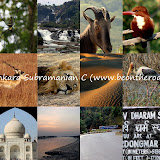
Keoladeo Ghana National Park or popularly known as Bharatpur bird sanctuary is located in north-eastern Rajasthan, near the Uttar Pradesh border, within the golden triangle of Agra, Delhi and Jaipur, just off NH11. The Keoladeo Ghana national park is a gem in India’s ecological crown despite being one of the smallest parks in the country.

Declared a World Heritage Site in 1985, this national park measures 29 sq km in area of which a third is made up by shallow freshwater lakes. Some 350 species of birds are visitors here while about 120 species nest in the park. Keoladeo Ghana also boasts of an amazing variety of flora, and as many as 181 genera are to be found here.

After a good 3 days and 3 nights in the Thar desert, I reached Bharatpur after spending a couple of days at Bikaner and a day at Jaipur. Checked into a hotel near the Bharatpur Bird Sanctuary. During my 3 day stay at this place I made 6 trips to the Bharatpur Bird Sanctuary. For each day, I would buy my entrance tickets at the main gate. Out of the 6 trips, I covered 4 of them on foot through a number of well maintained paths in the park, while I covered the remaining 2 trips on a cycle rickshaw. The cycle rickshaw pullers have been trained by the Bombay Natural History Society (BNHS) to recognize wildlife. The park is open from 6 am to 6 pm and field guides and maps are sold at the Tourist reception centre.

Since each trip was at different times of the day, early morning, broad daylight, dusk and post sunset, I was able to see diverse species of birds and animals.The ones near the swamps brought me the maximum number of sightings.

The 29 sq km of shallow jheels and marshes, scrub jungle, marsh green woods and golden grass of the Bharatpur Bird Sanctuary plays host to over 400 species of birds – about as much as in the entire UK. This World Heritage Site, however, did not start off as a sanctuary. It was conceived and designed by the Maharaja of Bharatpur for the single purpose of shooting birds. In fact, on one particular shoot held in the honour of Lord Linlithgow, the viceroy, during the heady days of the Raj, more than 4,000 birds were shot down. The shooting records were etched on sandstone plaques near the Keoladeo temple.

In 1971, the guns fell silent thanks to the efforts of India’s most famous ornithologist, the late Salim Ali. Today, this World Heritage Site is famous for its heronries and, of course, the sadly dwindling numbers of the great white (Siberian) cranes that visit during the balmy winters, along with thousands of other migrants – waterfowl, waders, passerines and raptors.

The colony I saw was a like a multi-cultural avian metropolis. Frenzied feeding, flying in unison at the slightest disturbance, cacophony in the air, huge nesting colonies were some of the sights and senses that I experienced during my 3 days here.

Apart from birds, I was able to spot Indian fox, Rhesus Macaque, Common Mongoose, nilgai (bluebull), sambar deer, chital (spotted deer) and a couple of jackals. In addition, a solitary monitor lizard on a dead tree trunk and to my amazement it stayed immobile in that position for all of my 3 days. I guess it was still digesting its food. I was also lucky in spotting the famous residents of this sanctuary – the big rock pythons that inhabit the various ‘Python Points’ in the park.

Following is a list of the amazing bird life I spotted during my 3 days at the Bharatpur Bird Sanctuary ala Keoladeo National Park: Oriental Honey Buzzard, Rose-ringed Parakeet, White-eared Bulbul, Oriental White Ibis, Yellow Throated Pied Woodpecker, Red Wattled Lapwing, Indian Pond Heron, White Breasted Kingfisher, Small Minivet, Painted Stork, Little Egret, Grey Heron, Eurasian spoonbill, Median Egret, Comb Duck, Large Egret, Little Cormorant, Darter, Red Junglefowl, Peafowl, Black shouldered Kite, Egyptian Vulture, Large tailed Nightjar, Black Redstart (male and female), Collared Scops Owl, Purple Heron, Small Blue Kingfisher, Sarus Crane, Spot billed Duck, Marsh Harrier, White-breasted Water Hen, Black Crowned Night Heron, Common Coot, Indian Moore Hen, Gadwall, Large Cormorant/Indian Shag, Lesser Whistling Duck, Greater Coucal, Oriental Magpie Robin, Purple Moore Hen, White Necked Stork, Gloss Ibis, Greylag Goose, Bar Headed Goose, Jungle Babbler, Dusky Eagle Owl, Northern Pintail and Common Teal.
To see India through the eyes of a motorcyclist’s lens, visit the album below.
 |
| my solo all-india motorcycle journey |
5th picture The most amazing And beautiful.
ReplyDeleteThanks for sharing. I wish I was with you during tours.